Martienssen W., Warlimont H. (Eds.). Handbook of Condensed Matter and Materials Data
Подождите немного. Документ загружается.

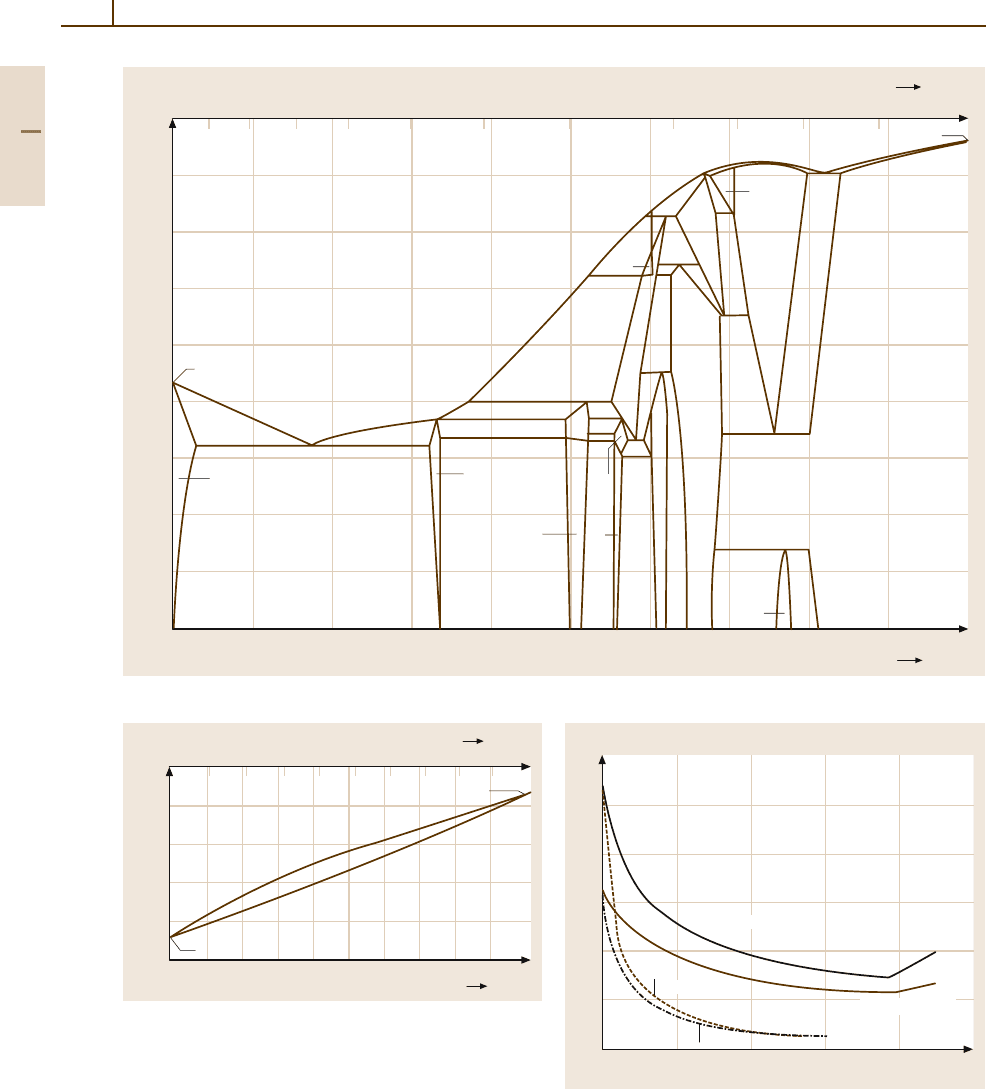
302 Part 3 Classes of Materials
1400
1300
1200
1100
1000
900
800
700
600
500
10 20 30 40 50 60 70 80 85 90 95
Al Cu10 20 30 40 50 60 70 80 90
Al–Cu
(wt %)Cu
(at. %)Cu
T(K)
933.5 K
821 K
836 K
864 K
897 K
(Al)
θ
η
2
ζ
2
840 K
636 K
(Cu)
ζ
1
η
1
α
2
ε
1
ε
2
γ
1
δ
γ
0
β
β
0
1320 K
1356 K
Fig. 3.1-135 Cu
−
Al phase diagram [1.106]
1800
1700
1600
1500
1400
1300
10 20 30 40 50 60 70 80 90
10 20 30 40 50 60 70 80 90Cu
Ni
(at.%)
Ni
(wt %)
Ni
T(K)
Cu–Ni
1357.87 K
1728 K
(Cu, Ni)
L
Fig. 3.1-136 Cu
−
Ni phase diagram [1.106]
60
50
40
30
20
10
0
10 20 30 40
Specific electrical conductivity (MS/m)
Zn, Ni (wt %)
Cu-Zn 20 °C
Cu-Zn 200 °C
Cu-Ni 20 °C
Cu-Ni 200 °C
Fig. 3.1-137 Electrical conductivity of Cu
−
Ni and Cu
−
Zn
alloys [1.103]
Part 3 1.8
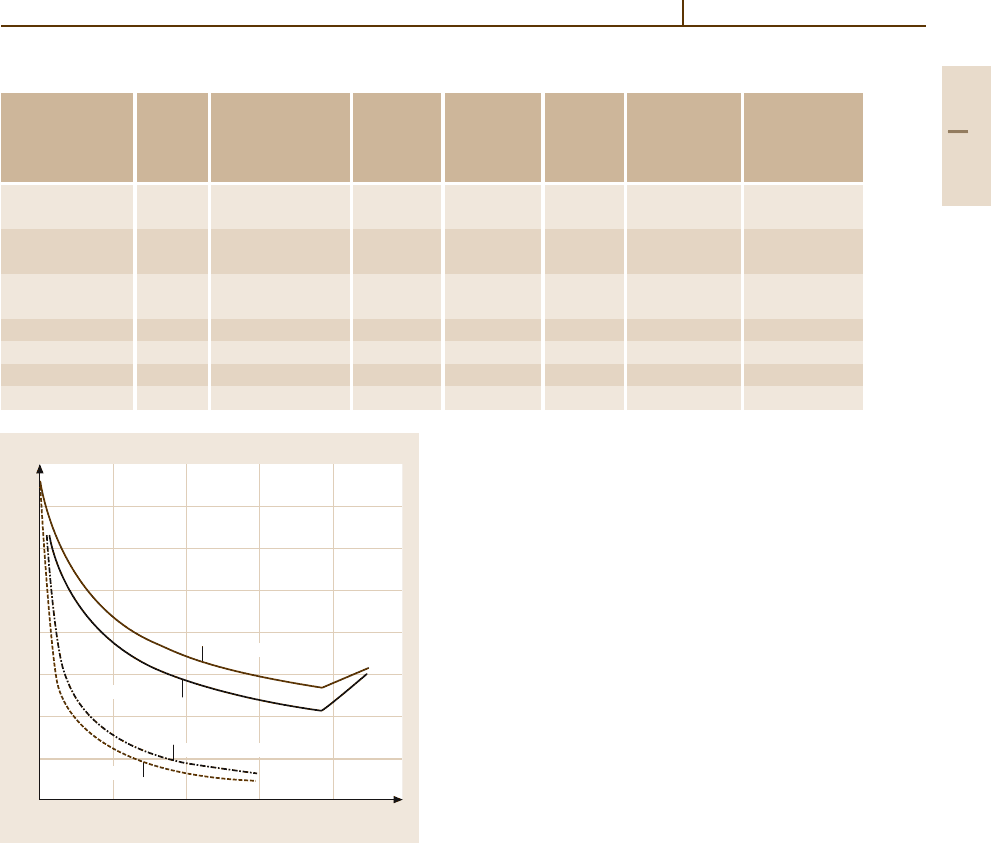
Metals 1.9 Refractory Metals and Alloys 303
Table 3.1-107 Composition and properties of characteristic copper–nickel and copper–nickel–zinc alloys
Material UNS No. Purity; other Yield Ultimate Fracture Thermal Electrical
elements (wt%) stress R
po.2
tensile strain conductivity κ resistivity ρ
(MPa) strength R
m
A
f
(%) (Wm
−1
K
−1
) (µ cm)
(MPa)
Copper nickel C70400 92.4 Cu–5.5Ni 276–524 262–531 2–46 67 13.79
–1.5 Fe–0.6Mn
Copper nickel C70600 87.7 Cu–10 Ni 110–393 303–414 10–42 42 21.55
–1.5 Fe–0.6Mn
Copper nickel C71500 67 Cu–31 Ni 138–483 372–517 15–45 21 38.31
–0.7 Fe–0.5Be
Nickel silver 10% C74500 65 Cu–25 Zn–10 Ni 124–524 338–896 1–50 37 20.75
Nickel silver 12% C74500 65 Cu–23 Zn–12 Ni 124–545 359–641 2–48 30 22.36
Nickel silver 15% C75200 65 Cu–20 Zn–15 Ni 124–545 365–634 2–43 27 24.59
Nickel silver 18% C74500 65 Cu–17 Zn–18 Ni 172–621 386–710 3–45 28 27.37
400
350
300
250
200
150
100
50
0
10
20 30 40
Zn, Ni (wt %)
Thermal conductivity (Wm
–1
K
–1
)
Cu-Zn 200 °C
Cu-Zn 20 °C
Cu-Ni 200 °C
Cu-Ni 20 °C
Fig. 3.1-138 Thermal conductivity of Cu
−
Ni and Cu
−
Zn
alloys [1.103]
3.1.9 Refractory Metals and Alloys
Several books and reviews have been published on the
technology and properties of refractory metals and their
alloys [1.107–116]. According to the most common defi-
nition, refractory metals comprise elements of the Group
Va and VIa with a melting point higher than 2000
◦
C;
these are niobium, tantalum, molybdenum, and tungsten.
In some publications the VIIa metal rhenium is also in-
cluded, as it does not fit in any other classification. Less
common definitions describe a refractory metal as metal
with a melting point equal to or greater than that of
chromium, thus additionally including vanadium, tech-
netium, the reactive metal hafnium, and the noble metals
ruthenium, osmium, ruthenium, and iridium. This chap-
ter will give data on molybdenum, tungsten, tantalum,
niobium, and their alloys. Powder metallurgy (P/M) is
the only production route for commercial W and W al-
loys and for 97% of Mo, the remainder is processed
by electron-beam melting (EB) and vacuum-arc casting
(VAC) [1.117]. The finer grain structure of P/M-material
is advantageous for both the further processing and
the mechanical properties of the finished product. For
some alloys such as those doped with potassium silicate,
La
2
O
3
, and Y
2
O
3
, P/M is the only possible production
technique.
Part 3 1.9

304 Part 3 Classes of Materials
Die-pressing
Mo, W, Ta
Powder
Mo, W, Ta
Cold-isostatic pressing
Mo, W, Ta
Powder-injection
molding Mo, W
Extrusion of plasti-
fied powder Mo, W
Spray-forming
W, Ta
Indirect heating
(resistance heating elements
or induction radiant heating
Mo, W, Ta
Direct heating
(self-resistance heating)
Mo, W, Ta
Deformation
Mo, W, Ta
Hot isostatic pressing
or uniaxial hot pressing
Mo, W, Ta
Infiltration
Mo, W
Shaping
and
compaction
Sintering
Full density
processing
Fig. 3.1-139 Large-scale P/M production routes for Mo, W and Ta [1.118]
The mechanical properties and homogenous mi-
crostructure required are again the reasons to apply P/M
in producing Ta wire as employed extensively in the
manufacture of capacitors. The larger fraction of the Ta
sheet production is based on the use of EB sheet bars, as
this is more economical. The techniques of VAC and EB
dominate in the production of Nb and Nb alloys. The in-
dustrial P/M production routes of Mo, W, Ta, and their
alloys are given in Fig. 3.1-139.
Net shape techniques such as powder injection
molding and spraying on a lost core (vacuum-plasma-
spraying, chemical vapor deposition) are limited to some
specific applications in the field of electronic devices
and aerospace products. Less than 10% of the produc-
tion quantity is delivered in the as-sintered state. The
most common fully-dense-processing techniques are
deformation by rolling, forging, swaging, and drawing.
Initially refractory metals were applied mainly in
the pure state. Extensive developments mainly driven by
US aerospace programs led to a wide variety of alloys
now commercially available. The compositions of solid-
solution, precipitation- and dispersion-strengthened
alloys are given in Table 3.1-108. Tungsten heavy met-
als and refractory-metal-based composite materials are
not included here.
Carbide precipitation hardening (in TZM, MHC)
is effective up to 1400
◦
C. The addition of the de-
formable oxides La
2
O
3
(in ML) and xK
2
O· y SiO
2
(in
K
−
Si
−
Mo), respectively, results in oxide refinement by
deformation and in the possibility of tailoring the mech-
anical properties. This is the main alloying mechanism
for Mo applied in lamps [1.119].
The tungsten alloy which is commercially most
important is Al
−
K-silicate doped W (AKS–W). It is
a dispersion-strengthened, micro-alloyed metal with
a directionally recrystallized microstructure. Spherical
bubbles stabilized by containing potassium gas are inter-
acting with dislocations, sub-boundaries and high-angle
boundaries [1.120,121]. The high stability of these bub-
bles can be explained by the low solubility of K in W,
even at operating temperatures up to 3200
◦
C.
A current task is to reduce the low-temperature brit-
tleness of Mo and W, which is essentially due to a rigid
covalent component of the interatomic bond along the
edges of the bcc unit cell. This causes a low solubility for
interstitial elements which occupy the octahedral sites
of the lattice and give rise to its tetragonal distortion and
a strong interaction of dislocations with the elastic strain
field surrounding the interstitial solutes, thus impeding
the dislocation movement [1.122]. One possibility to
increase the low-temperature ductility is alloying with
rhenium which lowers the brittle-to-ductile-transition
temperature of both W and Mo [1.123–125]. But the
insufficient supply and the high price of rhenium limit
the application of these alloys.
The addition of oxides such as ThO
2
,BaO,SrO,
Y
2
O
3
,andSc
2
O
3
lowers the electron work function
of W, which is important for its application in elec-
trodes. The production quantities of W
−
La
2
O
3
and
W
−
Ce
2
O
3
as electron emitting materials are increas-
ing at the expense of the slightly radioactive W
−
ThO
2
material.
The production of capacitors, the dominating ap-
plication of Ta, requires material in its purest state.
Part 3 1.9
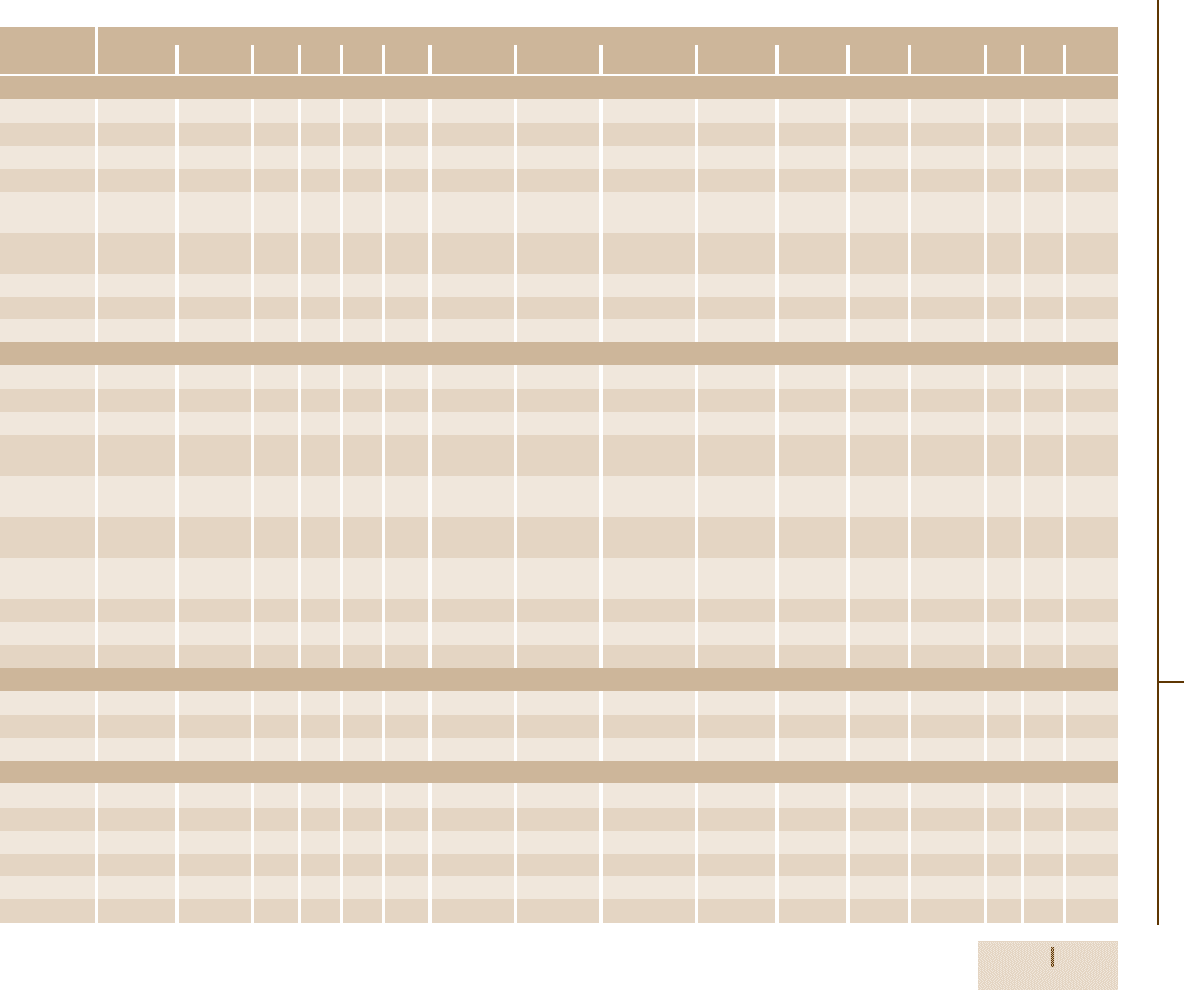
Metals 1.9 Refractory Metals and Alloys 305
Table 3.1-108 Typical compositions of commercial refractory metal alloys (in weight percent, analyses of base-metal correspond to metallic purity) [1.118]
Alloy
designation Mo W Ta Nb Re C O Si K Y La Ce Th Ti Zr Hf
Molybdenum alloys
Pure Mo 99.97
UHP-Mo 99.9995
TZM 99.3 0.025 0.02 0.5 0.08
MHC 98.6 0.08 0.035 1.2
Mo
−
La
2
O
3
99.2–99.6 0.048–0.1 0.27–0.6
(ML)
Mo
−
Y
2
O
3
99.42 0.10–0.12 0.37–0.43 0–0.06
(MY)
K
−
Si
−
Mo 99.8–99.9 0.01–0.07 0.013–0.07 0.005–0.03
Mo50Re 52.4 47.5
Mo30W 69.7 30
Tungsten alloys
Pure W 99.99
UHP-W 99.9995
AKS-W 99.98 0.004–0.01
W
−
La
2
O
3
97.9–98.9 0.015–0.03 0.85–1.7
(WL)
W
−
Ce
2
O
3
98.0 0.28 1.62
(WC)
W
−
ThO
2
98.0 0.24 1.71
(WT)
AKS- 98.0–99.0 0.12–0.24 0.001–0.005 0.86–1.71
W
−
ThO
2
W5Re 94.9 5.0
W26Re 73.9 26
AKS-W3Re 96.9 3.0 0.004
Tantalum alloys
Pure Ta 99.95
Ta2.5W 2.5 97.4
Ta10W 10.0 89.9
Niobium alloys
Pure Nb 99.9
Nb1Zr 98.9 1.0
C-103 88.8 1 10
FS-85 10 28 60.8 1
WC-3009 9 60.8 0.1 30
Nb−46.5Ti 46.5
Part 3 1.9
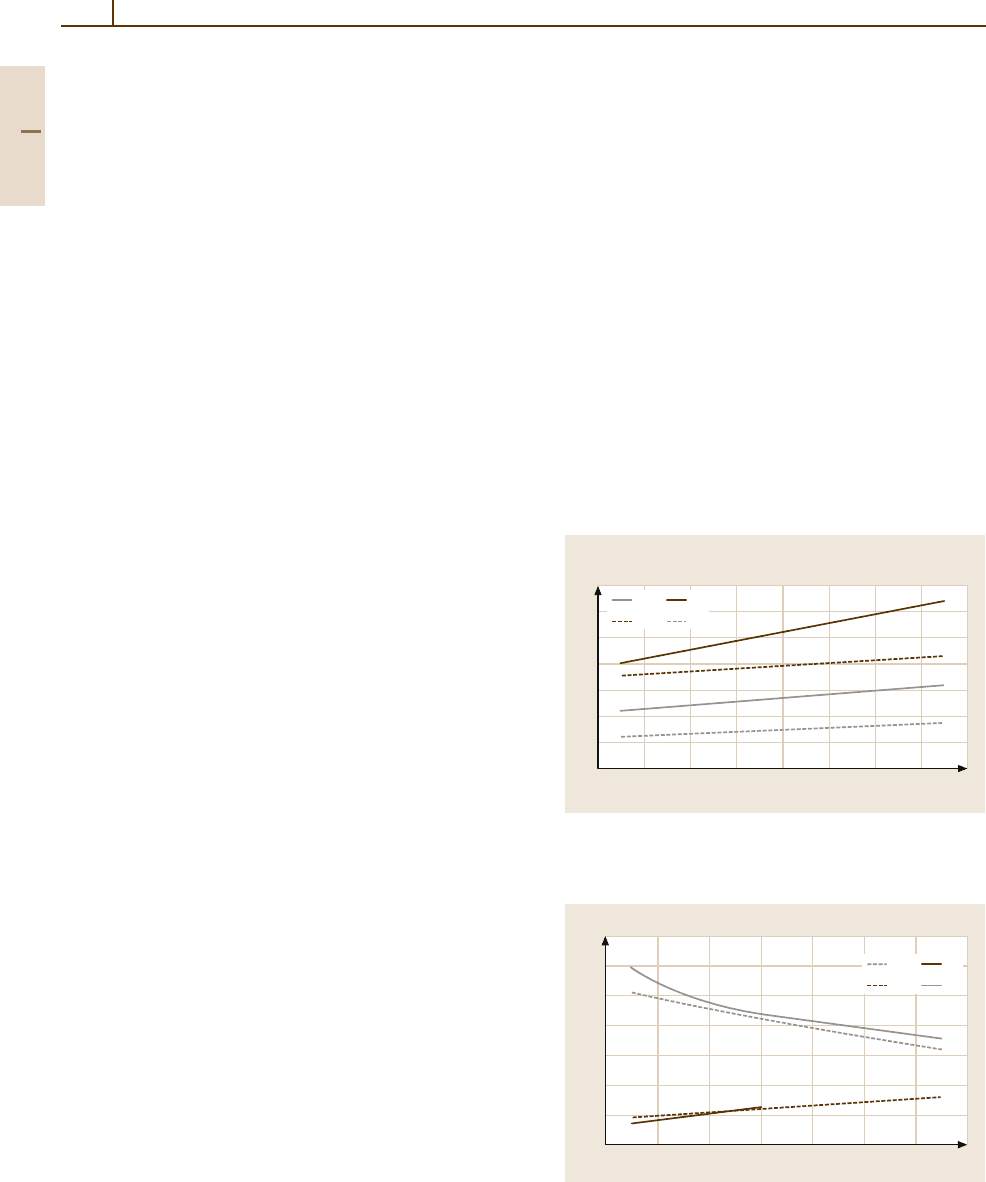
306 Part 3 Classes of Materials
Solid-solution-strengthened Ta2.5W is used for compo-
nents in chemical apparatus. Superconducting Nb46.5Ti
accounts for more than half of all Nb alloys produced.
Hafnium is the main addition for niobium-based alloys
used by the aerospace industry.
Refractory metals and their alloys are used in a wide
variety of fields of application and products such as
electrical and electronic devices; light sources; medical
equipment; automotive, aerospace, and defense indus-
try; chemical and pharmaceutical industry; or premium
and sporting goods.
The producers of electrical and electronic devices,
including the lighting industry, are the largest consumers
of refractory metal products. In 1998, 1850 t of W prod-
ucts was used for filaments and electrodes in lamps
only. Significant quantities of Mo are used for semi-
conductor base-plates for power rectifiers and in various
products for lamps, such as dipped beam shields or sup-
port wires. Rapid growth in multimedia and wireless
communication networks systems has boosted the need
for W
−
Cu and Mo
−
Cu heat sink materials. These ma-
terials possess a high thermal conductivity combined
with a low thermal expansion, close to those of Si
and GaAs semiconductors or certain packaging mater-
ials. Also, the amount of Mo sputtering targets applied
in the production of wiring for large format thin-film
transistor LCDs and PDPs has risen significantly ow-
ing to the unique combination of low resistivity and
high resistance against hillock formation. The electronic
industry is the largest market (around 70%) for Ta prod-
ucts, employing the metal mainly in the manufacture of
capacitors.
Refractory metals are also widely used by the ma-
terials processing industry. Molybdenum glass melting
electrodes, TZM and MHC isothermal forging tools,
weighing several tons per part, TZM piercing plugs
for the production of stainless steel tubes, Mo and Ta
crucibles for synthesizing artificial diamond, or TIG-
welding electrodes are examples of products in this field.
In order to improve the tribological properties of trans-
mission and engine components for automobiles they
are coated with Mo.
Recent products in the field of aerospace and defense
industry are shaped charge liners made of Mo and Ta
penetrators formed explosively. The X-ray anode, a com-
posite product made of W5Re or W10Re, TZM and
optionally graphite, is the essential item of computer-
Fig. 3.1-141 Thermal conductivity versus temperature of
molybdenum [1.126], tungsten [1.129], niobium [1.127],
and tantalum [1.127]
tomography equipment, a very demanding application
that critically depends on the users’ expertise.
3.1.9.1 Physical Properties
The atomic and structural properties of the pure refrac-
tory metals are listed in Chapt. 2.1, Tables 2.1-12 and
2.1-14. Special features of refractory metals are their
low vapor pressure, low coefficient of thermal expan-
sion, and the high thermal and electrical conductivity of
Mo and W. This combination of physical properties has
opened up a wide range of new applications during the
last decade, especially in the field of electronics.
The coefficient of linear thermal expansion, the
thermal conductivity, the specific heat, and the elec-
trical resistivity as function of temperature are shown
in Figs. 3.1-140 – 3.1-143. The vapor pressure and rate
of evaporation are shown in Fig. 3.1-144. In the case of
precipitation- and dispersion-strengthened molybdenum
alloys, such as TZM, MHC, ML, MY, and K
−
Si
−
Mo,
10
9
8
7
6
5
4
3
0 200 400 600 800 1000 1200 1400 1600
T(°C)
(× 10
–6
)
Coefficient of linear thermal
expansion (m/m
#
)
Nb
Ta
Mo
W
Mo Nb
Ta W
Fig. 3.1-140 Coefficient of linear thermal expansion ver-
sus temperature of molybdenum [1.126], tungsten [1.126],
niobium [1.127], and tantalum [1.128]
180
160
140
120
100
80
60
40
0 200 400 600 800 1000 1200 1400
T(°C)
Thermal conductivity (W/mK)
Mo Nb
Ta W
W
Mo
Ta
Nb
Part 3 1.9
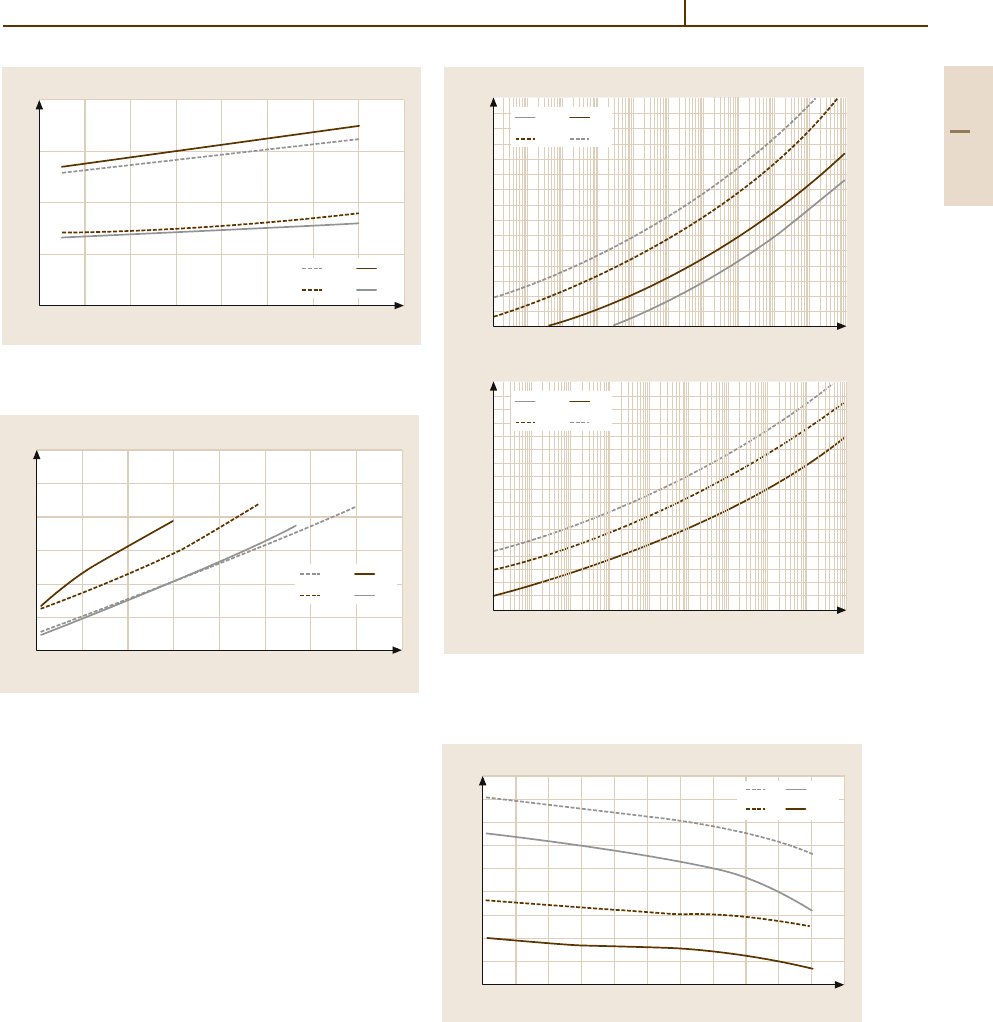
Metals 1.9 Refractory Metals and Alloys 307
0.4
0.3
0.2
0.1
0
Specific heat (J/g
#
k)
0 200 400 600 800 1000 1200 1400 1600
T(°C)
Mo Nb
Ta W
Nb
Mo
Ta
W
Fig. 3.1-142 Specific heat versus temperature of molybde-
num, tungsten, niobium, and tantalum [1.126]
0.6
0.5
0.4
0.3
0.2
0.1
0.0
0
200
400
600
800
1000
1200
1400
1600
T(°C)
Mo Nb
Specific electrical resistivity (Ω mm
2
/m)
Nb
Ta
Mo
Ta W
W
Mo
Fig. 3.1-143 Specific electrical resistivity versus tem-
perature of molybdenum [1.126], tungsten [1.126],
niobium [1.127], and tantalum [1.127]
as well as the tungsten based alloys AKS–W, WL, WC,
and WT, the physical properties do not differ signif-
icantly from those of the pure metals. Values for the
Young’s modulus and its temperature dependence are
plotted in Fig. 3.1-145. TheYoung’s moduli of the Group
Va metals are considerably lower than those of the
Group VIa metals due to the differences in electronic
structure.
The strong influence of the surface conditions on
the emissivity and lack of information in the literature
concerning pre-treatment make it difficult to interpret
emissivity data. An overview of emissivity measure-
ments for W, Nb, and Ta at 684.5 nm from 1500
◦
C
up to the liquid phase using laser polarimetry is given
in [1.130].
10
–10
2900
2700
2500
2300
2100
1900
1700
1500
Vapor pressure (Pa)
10
–9
10
–8
10
–7
10
–6
10
–5
10
–4
10
–3
10
–2
10
–1
10
0
10
–7
2900
2700
2500
2300
2100
1900
1700
1500
1300
Evaporation rate (mg/cm
3
h)
10
–6
10
–5
10
–4
10
–3
10
–2
10
0
10
1
10
2
10
–1
T(°C)
Mo Nb
Ta W
W
Ta
Nb
Mo
T(°C)
Mo Nb
Ta W
W
Ta
Nb
Mo
a)
b)
Fig. 3.1-144a,b Vapor pressure (a) and evaporation rate
(b) versus temperature of molybdenum, tungsten, niobium,
and tantalum [1.129]
450
400
350
300
250
200
150
100
50
0
0 200 400 600 800 1000120014001600180020002200
T(°C)
Mo
Nb
Ta
W
Young’s modulus (GPa)
Fig. 3.1-145 Young’s moduli versus temperature of molyb-
denum, tungsten, niobium, and tantalum [1.128]
Part 3 1.9

308 Part 3 Classes of Materials
3.1.9.2 Chemical Properties
Refractory metals are highly resistant to many chem-
ical agents. Tantalum is outstanding in its performance
as it is inert to all concentrations of hydrochloric and
nitric acid, 98% sulphuric acid, 85% phosphoric acid,
and aqua regia below 150
◦
C. Tantalum can be attacked
by hydrofluoric acid and strong alkalis, however. The
excellent corrosion resistance of Ta is attributed to
dense natural oxide layers which prevent the chem-
ical attack of the metal. Niobium is less resistant
than Ta and embrittles more easily. Nevertheless the
more economical Nb has replaced Ta in some applica-
tions. Molybdenum and W are highly resistant to many
molten glasses and metals as long as free oxygen is
absent.
The interaction with H, N, and O is widely differ-
ent for Mo and W on the one hand, and Nb and Ta
on the other. Molybdenum and W have almost no sol-
ubility, whereas Nb and Ta can dissolve a considerable
amount of these elements. Hydrogen can be removed
from Nb at 300
◦
C to 1600
◦
C and from Ta at 800
◦
C
to 1800
◦
C without metal loss by degassing in high vac-
uum. For the removal of N, temperatures higher than
1600
◦
C are recommended. The evaporation of volatile
oxides at temperatures above 1600
◦
C in high vacuum
leads to a reduction of the oxygen content in Nb and
Ta. But during such heat treatments, metal is evaporated
simultaneously.
An overview on the resistance of pure Mo, W, Nb,
and Ta against different media is given in Tables 3.1-109
Table 3.1-109 Metal loss of Mo, W, Nb and Ta in millimeter per year (mm/yr) in acids, alkalis and salt solutions
Corroding agent Temperature Metal loss (mm/yr)
(aqueous solution)
Mo W Nb Ta
10% HCl 20
◦
C < 0.003 0.002 0 < 0.001
10% H
2
SO
4
20
◦
C < 0.005 < 0.1 < 0.1 < 0.1
10% HNO
3
20
◦
C 18.6 < 0.25 < 0.013 < 0.013
3% HF 20
◦
C < 0.001 < 0.1 > 3.0 > 3.0
10% CH
3
COOH 20
◦
C 0.07 < 0.05 < 0.1 < 0.013
10% KOH 20
◦
C < 0.1 < 0.1 < 0.2 < 0.1
3% NaCl 20
◦
C < 0.1 < 0.1 < 0.1 < 0.1
10% HCl 100
◦
C < 0.025 0.005 0.005 (embrittlement) < 0.025
10% H
2
SO
4
100
◦
C 0.17 < 0.25 < 0.001 0
10% HNO
3
100
◦
C 150 < 0.25 < 0.076 < 0.025
3% HF 100
◦
C 0.18 0.15 > 3.0 > 3.0
10% CH
3
COOH 100
◦
C 0.033 < 0.05 < 0.1 < 0.013
10% KOH 100
◦
C 0.054 0.01 1.2 (embrittlement) < 0.003 (embrittlement)
3% NaCl 100
◦
C < 0.1 < 0.1 < 0.1 < 0.1
to 3.1-111. In accordance with the definition given
in [1.131], a material is considered “stable” against acor-
rosive medium if the metal loss is < 0.1 mm per year. If
the loss of material is between 0.1 and 1.0 mm per year,
the material is “considerably stable;” and it is “fairly un-
stable” if the loss of material is between 1.0 and 3.0 mm.
The material is “unsuitable” in an environment if the
metal loss is > 3.0 mm per year.
Oxidation Behavior
Refractory metals require protection from oxidizing en-
vironment as they do not form protective oxide layers.
Oxidation of Mo and W leads to a loss of material by the
formation of volatile oxides above 600
◦
C, but without
any significant impact on the mechanical properties.
The low temperature oxidation of Mo and W of-
ten causes problems in practical use as thin corrosion
films are formed during storage in moist air. The surface
topography of Mo has a strong impact on the reac-
tion rate. The corrosion film contains oxygen but also
chemically-bonded nitrogen, which is incorporated in
the film during film growth. C
x
H
y
residues are the nu-
clei for the oxidative attack in the early stage of film
growth [1.132].
There is extensive evidence that between 300 and
500
◦
C, oxide-dispersion-strengthened (ODS) refrac-
tory metal alloys (e.g., Mo
−
La
2
O
3
and Mo
−
Y
2
O
3
grades) possess markedly reduced oxidation rates
compared to the pure metals [1.133]. In-situ oxida-
tion and evaluation of the binding state reveal that
MoO
2
dominates over MoO
3
both for Mo and Mo–
Part 3 1.9
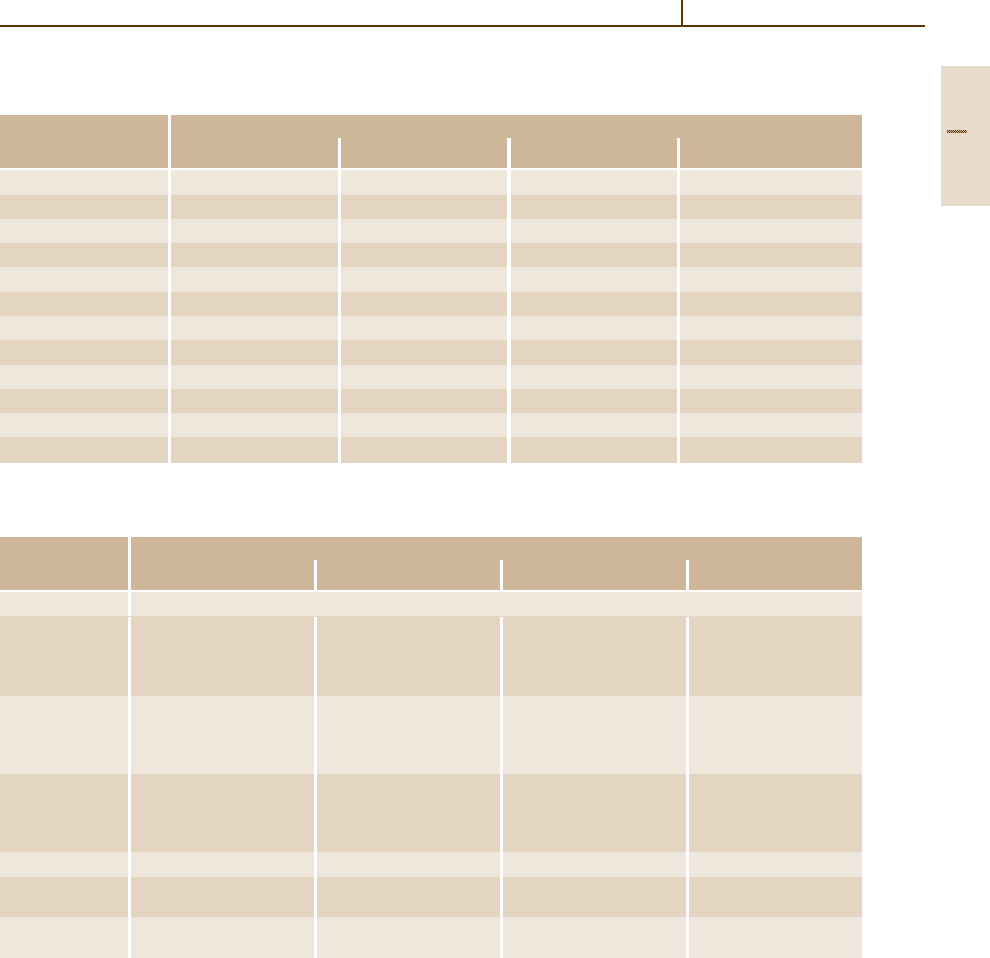
Metals 1.9 Refractory Metals and Alloys 309
Table 3.1-110 Maximum temperatures for the resistance of Mo, W, Nb, and Ta against metal melts (up to the stated
temperatures the solubility of the refractory metal in the metal melts and vice versa is negligible)
Metal melt Maximum resistance temperature (
◦
C)
Mo W Nb Ta
Al Not resistant 680 Not resistant Not resistant
Pb 1100 1100 850 1000
Fe Not resistant Not resistant Not resistant Not resistant
Ga 300 800 400 450
K 1200 900 1000 1000
Cu 1300 Resistant Resistant Resistant
Mg 1000 600 950 1150
Na 1030 900 1000 1000
Hg 600 600 600 600
Zn 500 750 Not resistant 500
Sn 550 980 Not resistant 260
Ag Resistant Resistant Resistant 1200
Table 3.1-111 Maximum temperatures for the resistance of Mo, W, Nb, and Ta against gaseous media at atmospheric
pressure
Gaseous media Maximum resistance temperature
Mo W Nb Ta
Air and oxygen see Sect. 3.1.9.2
Hydrogen Resistant Resistant 250
◦
C
(T > 250
◦
C
embrittlement owing to
dissolved hydrogen)
300
◦
C
(T > 300
◦
C
embrittlement owing to
dissolved hydrogen)
Nitrogen Resistant Resistant 300
◦
C
(T > 300
◦
C
embrittlement owing to
dissolved nitrogen)
400
◦
C
(T > 400
◦
C
embrittlement owing to
dissolved nitrogen)
Ammonia Resistant
(except 1000–1100
◦
C:
nitration)
Resistant
(except 700–1150
◦
C:
nitration)
300
◦
C
(T > 300
◦
C
embrittlement owing to
dissolved nitrogen)
700
◦
C
(T > 700
◦
C
embrittlement owing to
dissolved nitrogen)
Water vapor 700
◦
C 700
◦
C 200
◦
C 200
◦
C
Carbon monoxide 800
◦
C
(T > 800
◦
C carburization)
1000
◦
C
(T > 800
◦
C carburization)
800
◦
C 1100
◦
C
Carbon dioxide 1200
◦
C
(T > 1200
◦
C oxidation)
1200
◦
C
(T > 1200
◦
C oxidation)
400
◦
C 500
◦
C
0.47 wt%Y
2
O
3
–0.08 wt%Ce
2
O
3
(Fig. 3.1-146). These
results are confirmed when comparing the thickness of
the oxide layer formed at 500
◦
C in air (Fig. 3.1-147).
The enhanced oxidation resistance of doped sam-
ples cannot be attributed to a chemical but rather to
a morphological-mechanical effect. Investigations of the
surface of pure Mo samples subjected to long-term ox-
idation reveal a network of cracks in the MoO
2
layer
which drastically diminishes the passivating effect of
this layer by facilitating a further attack by O. Such
cracks cannot be found on the surface of oxidized
Mo
−
La
2
O
3
and Mo
−
Y
2
O
3
samples [1.133].
Above 700
◦
C for Mo and approximately 900
◦
C
for W, evaporation of the volatile oxides MoO
3
and WO
3
is the rate-controlling process and the oxidation follows
a linear time dependence. Above 2000
◦
C for Mo and
2400
◦
C for W, the metal loss increases because of the
increasing vapor pressure of the pure metals. The time
Part 3 1.9
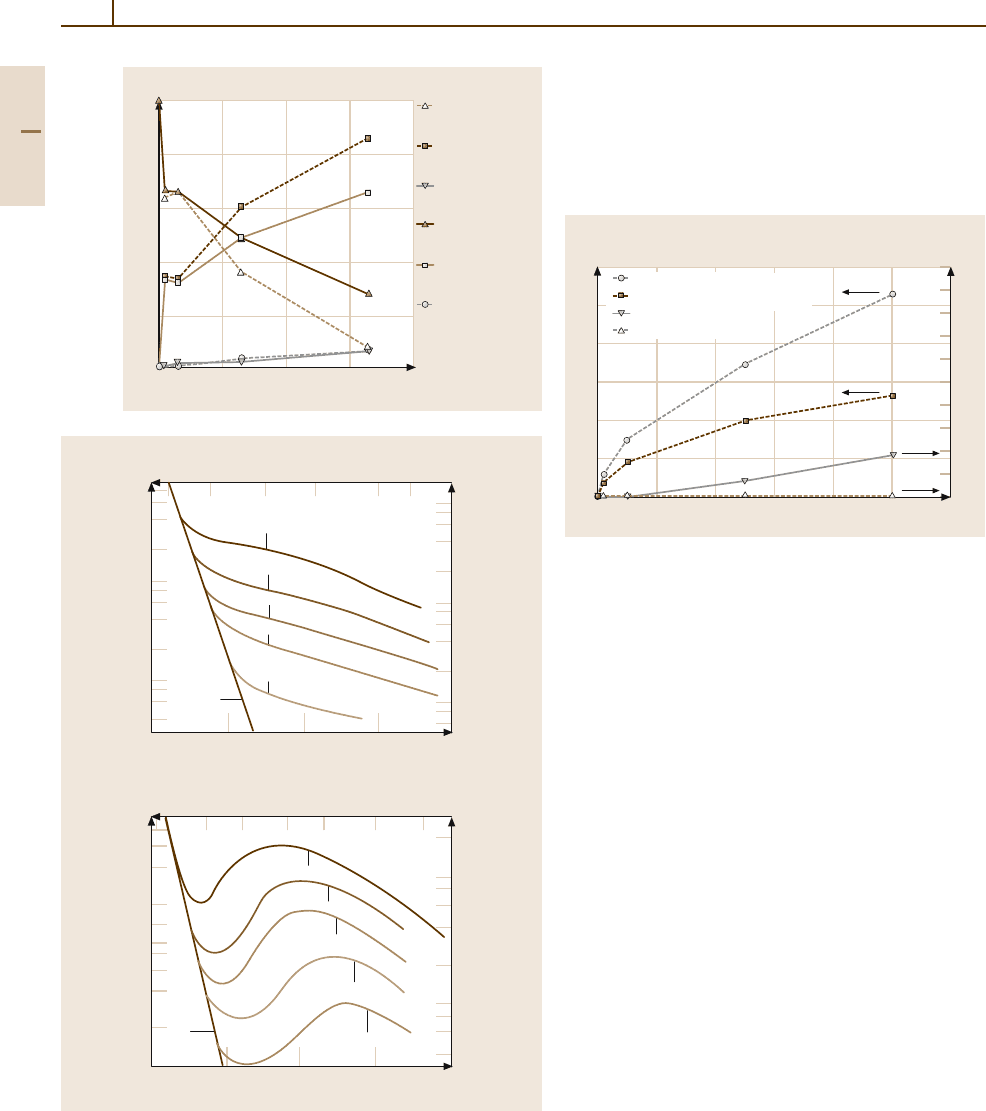
310 Part 3 Classes of Materials
100
80
60
40
20
0
(%)
Langmuir (L)
0 5000 10000 15000
20000
Mo/percentage
Mo
Mo/percentage
Mo
2
Mo/percentage
Mo
3
MY/percentage
Mo
MY/percentage
MoO
2
MY/percentage
MoO
3
10
0
8
6
4
2400 2100 1800
1600 1400 1300
10
2
6
4
8
2
6
4
8
2
6
8
10
1
10
0
4×10
–1
2
10
–1
8
6
4
2
10
–2
8
6×10
–3
3.6 4.4 5.2 6.0 6.8
10
4
/T (K
–1
)
3000 2400 2100
1800 1400 1200
10
1
6
4
8
2
6
4
8
2
10
0
10
–1
10
–2
4×10
–3
34567
10
4
/T (K
–1
)
1600
2×
10
–1
10
–1
8
6
4
2
8
6
T(°C)
∆
d
(µm/h)
∆
g
(mg/
cm
2
min)
a)
0.67 Pa
0.27 Pa
0.13 Pa
0.07 Pa
0.03 Pa
Mo
T(°C)
∆
d
(µm/h)
∆
g
(mg/
cm
2
min)
b)
W
0.03 Pa
0.07 Pa
0.13 Pa
0.27 Pa
0.53 Pa
Fig. 3.1-148a,b Metal loss in air for Mo (a) and W (b) at T ≥
1200
◦
C [1.134]
Fig. 3.1-146 ESCA measurements and evaluation of
Mo/MoO
2
/MoO
3
fraction versus in-situ oxidation con-
ditions in Langmuir (1 L = 10
−6
Torr s). Mo: 4N5 Mo
ribbon, electro-polished surface; MY: Mo–0.47 wt%Y
2
O
3
–
0.08 wt%Ce
2
O
3
ribbon, electro-polished surface, test
conditions: 500
◦
C/air [1.133]
60
50
40
30
20
10
0
Crack length/
area (mm/mm
2
)
50
45
40
35
30
25
20
15
10
5
0
Time (h)
0 100 200 300 400 500 600
Oxide layer
thickness (µm)
Mo (oxide layer thickness)
MY (oxide layer thickness)
Mo (crack length)
MY (crack length)
Fig. 3.1-147 Thickness of oxide layer and crack length
per area versus testing time. Mo: 4N5 Mo rib-
bon, electropolished surface; MY: Mo–0.47 wt%Y
2
O
3
–
0.08 wt%Ce
2
O
3
ribbon, electropolished surface, test
conditions: 500
◦
C/air [1.133]
dependence of metal loss for Mo and W at T ≥ 1200
◦
C
is shown in Fig. 3.1-148 [1.134].
The oxidation rates of Nb and Ta strongly depend
on temperature, pressure, and time. Different mecha-
nisms causing different oxidation rates can be observed
and metastable sub-oxides are formed during use in
O-containing atmospheres [1.131, 134]. Oxygen is dis-
solved in the metal matrix which leads to significant
changes of the mechanical properties. A poorly adher-
ent, porous pentoxide is formed on the metal surface
which does not protect the metal from further attack.
Oxygen which has penetrated the porous oxide layer
diffuses along the grain boundaries of the metal, leading
to drastic embrittlement.
The metal loss at 1100
◦
C due to oxidation in air is
shown for Mo, W, Nb, and Ta in Fig. 3.1-149 [1.135].
The embrittled zone caused by oxygen diffusion into the
substrate is not considered in this diagram.
Only a few coating systems have been found to pre-
vent the refractory metals from oxidation. In the case
of Mo, Pt-cladded components with a diffusion barrier
interlayer on the basis of alumina, which prevents the
formation of brittleintermetallic molybdenum–platinum
Part 3 1.9
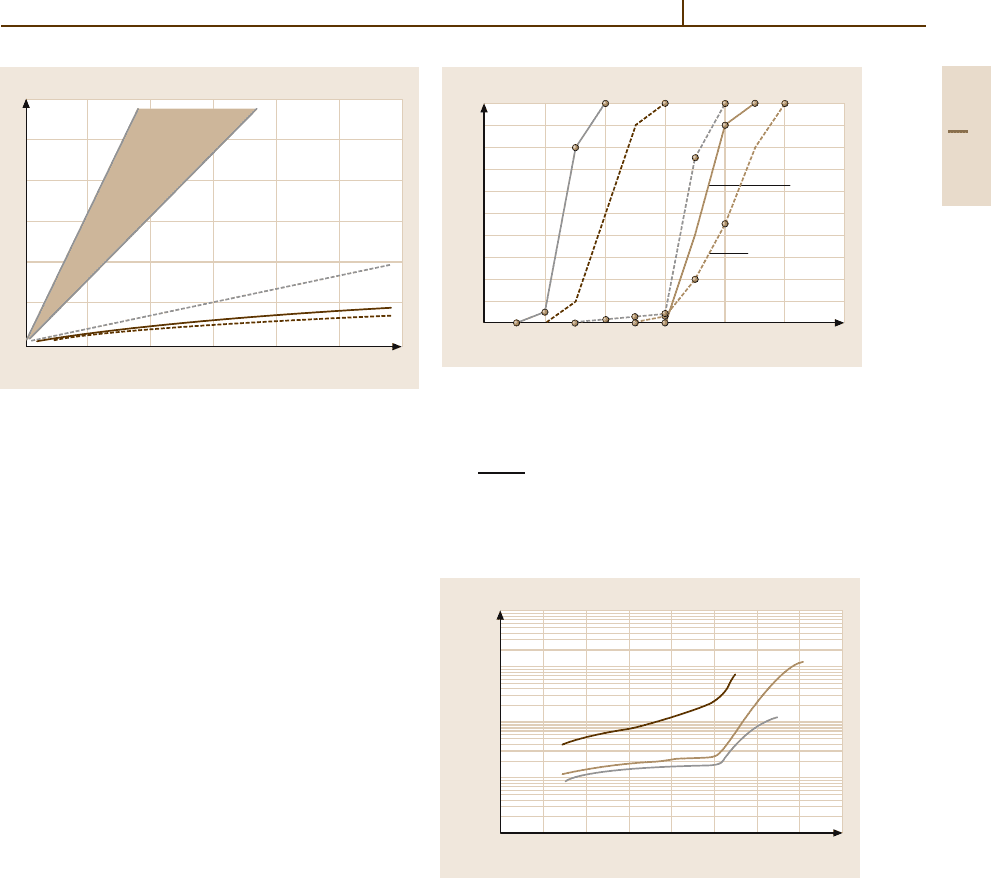
Metals 1.9 Refractory Metals and Alloys 311
6
5
4
3
2
1
0
Time (h)
024681012
Metal loss (mm)
Mo
W
Nb
Ta
Fig. 3.1-149 Oxidation behavior of Mo, W, Nb, and Ta at
1100
◦
C [1.135]
phases, are used; e.g., for stirrers used to homogenize
special glasses. Mo components for glass tanks and glass
melting electrodes are protected from oxidation by coat-
ings based on silicides, such as silicon–boron [1.136].
Silicon–boron and other silicide based coatings, such as
silicon–chromium–iron or silicon–chromium–titanium,
are also used to protect Mo and Nb based alloys from
oxidation in aerospace applications [1.135,137–139]
3.1.9.3 Recrystallization Behavior
The mechanisms and kinetics of recovery and recrys-
tallization processes significantly affect the processing
and application of refractory metals. The homologous
temperatures for obtaining 50% recrystallized struc-
ture during annealing for one hour, range from 0.39
for Mo, 0.41 for W, 0.42 for Nb, to 0.43 for P/M Ta.
The fraction of recrystallized structure as a function of
the annealing temperature of Mo, W, P/M Ta, TZM,
and Mo–0.7wt%La
2
O
3
sheets of 1-mm thickness is
shown in Fig. 3.1-150. Experimental data on the evo-
lution of grain size with the annealing temperature for
pure Mo and Ta sheets of 1-mm thickness are shown
in Fig. 3.1-151 [1.126,140]. A recrystallization diagram
for Mo is published in [1.141], and for P/M Ta in [1.142].
Compared to pure Mo, the recrystallization tempera-
ture of the carbide-precipitation-hardened alloy TZM is
increased by 450
◦
C and that of Mo–0.7wt%La
2
O
3
by
550
◦
C. The data listed in Table 3.1-112 show that all
those alloys containing particles, which deform together
with the matrix metal (ML, K
−
Si
−
Mo, WL10, WL15,
WT20, and AKS
−
W
−
ThO
2
), reveal a significantly
increased recrystallization temperature in the highly de-
100
90
80
70
60
50
40
30
20
10
0
Annealing temperature (°C)
600 800 1000 1200 1400 1600 1800
Mo
Ta
W
TZM
Mo–0.7 wt%
La
2
O
3
Percentage of recrystallized structure
Fig. 3.1-150 Fraction of recrystallized structure versus an-
nealing temperature (annealing time t
a
= 1h) for Mo,
P/M Ta, W, TZM, and Mo–0.7 wt% La
2
O
3
sheets
with a thickness of 1 mm, degree of deformation,
ϕ =
th
p
−th
s
th
p
100[%],whereth
p
= thickness of sintered
plate, and th
s
= thickness of rolled sheet. Mo: ϕ = 94%,
P/M Ta: ϕ = 98%, W: ϕ =94%, TZM: ϕ = 98%, Mo–
0.7 wt% La
2
O
3
: ϕ = 99% [1.126]
10000
1000
100
10
1
Annealing temperature (°C)
600 800 1000 1200 1400 1600 1800 2000 2200
Average grain size (µm)
EB Ta
P/M Mo
P/M Ta
Fig. 3.1-151 Grain size versus annealing temperature
(annealing time t
a
=1 h) for Mo, P/M Ta, and EB (electron-
beam melted) Ta sheets with a thickness of 1 mm. Mo:
ϕ = 94%, P/M Ta: ϕ = 98%, EB Ta: ϕ = 98% [1.126,140]
formed state. Increasing the degree of deformation from
ϕ = 90% to ϕ =99.99% leads to a further increase of
the recrystallization temperature (100% recrystallized
structure, 1 h annealing time) ranging from 600
◦
C for
K
−
Si
−
Mo, 700
◦
C for ML, 950
◦
C for WT20, 1000
◦
C
for WL10, to 1050
◦
C for WL15 and WC20. This can
be explained by particle refinement. During the de-
formation process the particles are elongated. During
annealing they break up and rows of smaller particles
Part 3 1.9
